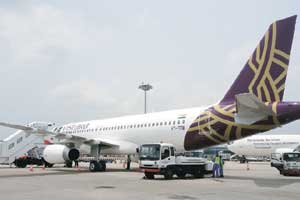While the full service carrier Vistara is reducing the number of seats in its business and premium economy class as part of its new plan, it still sees demand for them. The only thing, according to the airline is that its pricing should be right for which it has decided to offer deep discounts in business class fares beginning next month. The airline believes this will help it find the sweet spot between revenue per seat and load factor.
In the new seat configuration, Vistara’s aircraft will have 8 business class seat compared to twice as many till now. The premium economy seats would be reduced by one-third to 24. This would mean that the aircraft would have 126 economy seats compared to 96 as of now.
“Business class passengers are willing to pay more than economy but not 10 times or 6 times more. The secret of revenue maximization lies in filling up planes more than maximizing your fares,” Sanjiv Kapoor, chief strategic and commercial officer, told FE. He added that the industry’s experience suggests that lowering fares has often been compensated by increased demand. Kapoor, who was the chief operating officer of the then struggling SpiceJet before joining Vistara, employed deeply discounted fares at regular intervals to shore up demand. He believes similar strategy could work for Vistara to get more fliers in its premium and business class sections.
The full service airline, as part of its market research, found out that the business class demand has declined by 10% over the last two years, primarily due to excessively high fares for the business class seats and a sluggish economy. Vistara maintains that bringing down seats in business class and premium economy is an acknowledgment of sluggish demand but not an admission of doubt over profitability of a full service carrier in the country.
The airline has already started to test waters by slashing its business class fares by nearly 30% from its earlier fare for travel up to April 15. The carrier will review the passenger data from this period and take a decision on extending the same offer or possibly employing a new one with even deeper fare cuts, Kapoor said.
However, while Vistara business class fares are much lower than what they were before March 9 –the starting date for slashed fares—a look at its discounted fare and a comparison with competitor Jet Airways paints a mixed picture.
The two airlines are neck and neck in terms of fare on Delhi-Mumbai route. While on the Delhi-Bengaluru route, where Vistara has increased its frequency as part of its summer schedule, there is visible difference of approximately Rs 7,000 between the two full-service airlines. As for the Delhi-Ahmedabad route the prices quoted by both the airlines are almost the same.
“Overall prices of Vistara are almost equal to its competitors as of now despite the purported cut in its fares,” Jyoti Mayal, chairperson, airlines counsel, travel agents association of India (TAAI) told FE. She added that unless Vistara has a sustained long-term plan of cutting business class fares, it wouldn’t be able to differentiate its product from its competitors.
Given that a large chunk of business travelers are from corporate tie-ups, Vistara’s relatively small fleet – 9 A320s—serving fewer destinations compared to its competition has kept some corporates away from it. However, Vistara’s management said that with induction of 4 more aircraft this year along with its plan to re-launch its brand campaign would likely strengthen its position on the corporate deals front.
The full-service claims that from March 27, the airlines capacity will see a 25% increase due to improved utilization of aircraft and a further 50% increase by the end of this year with the help of its four new aircraft.
The company is also looking at increasing its flying hours to an excess of 12 hours per day. Vistara is of the opinion that all these strategies will help the airlines to boost its average passenger load factor which has been hovering just above 60% since it started its commercial operations.


